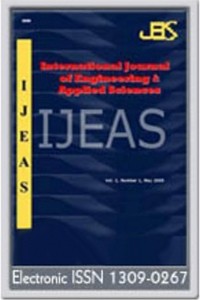Simulation of Bed Changes in Rivers with Finite Volume Method by Kinematic Wave Model
Predict of sediment particles movement is important mater, that can be help engineers to control flow structures, dams reservoirs, irrigation systems and etc. Simplification and sufficient sensible resolute cased to select one dimensional (1-D) approach for simulation of sediment transports. In this study we tried to simulate 1-D phenomena of sediment transport with explicit and implicit schemes in equilibrium conditions. In order to solve government equations used finite volume method by upwind scheme. Finally the model has been verified by Laboratory research and the results are generally fitted well in with the measurements
Keywords:
Sediment transport, 1-D model, Finite volume method, Kinematic wave model Explicit, Implicit,
___
- Versteeg, H.K., & Malalasekera, W.(1995). An introduction to computational fluid dynamics the finite volue method (1th ed.).New york:Longman scientific & technical.
- Wu,W.(2007) .Computational River Dynamics (1th ed.). Netherland: Taylor & Francis e- Library.
- Tayfur,G.,& Singh,P.(2006). Kinematic wave model of bed profiles in alluvial channels.
- Water Resources Research, W06414,1-13.
- WU, W., & S.Y. WANG, S. (2008). One-dimensional explicit finite-volume model for sediment transport with transient flows over movable beds. Journal of Hydraulic Research, (1),87- 98.
- WU, W. ,& Yang, G.(2001) . 1-D sediment numerical model and its application, us-china worship on advanced computational modeling in hydroscience & engineering, 1-11
- Seo, I.W.,Jun, I., & Choi, H.S.(2009) 1-D Finite element model for suspended sediment transport analysis. World City Water Forum.ss-p24,3107-3112
- Fang,H., Chen, M., & Chen, Q.(2008) One-dimensional numerical simulation of non- uniform sediment transport under unsteady flows, International Journal of Sediment Research ,23 (4), 316-328
- Soni, J. P. (1981a), Laboratory study of aggradation in alluvial channels,J. Hydrol., 49, – 106.
- Soni, J. P. (1981b), An error function solution of sediment transport in aggradation channels, J. Hydrol., 49, 107– 119.
- Soni, J. P. (1981c), Unsteady sediment transport law and prediction of aggradation parameters,
- Water Resour. Res., 17(1), 33–40. Lisle, T. E., Y. T. Cui, G. Parker, J. E. Pizzuto, and A. M. Dodd (2001), The dominance of dispersion in the evolution of bed material waves in gravelbed rivers, Earth Surf. Processes Landforms, 26, 1409– 1420.
- Langbein, W. B., and L. B. Leopold (1968), River channel bars and dunes: Theory of kinematic waves, U. S. Geol. Surv. Prof. Pap., 422-L, 20 pp.
- Wathen, S. J., and T. B. Hoey (1998), Morphological controls on the downstream passage of a sediment wave in a gravel-bed stream, Earth Surf. Processes Landforms, 23, – 730.
- Guy, H. P., D. B. Simons, and E. V. Richardson (1966), Summary of alluvial channel data from flume experiments, 1956–1961, U.S. Geol. Surv. Prof. Pap., 462–I, 96 pp.
- A.(2010),One dimensional flow and sediment transport fully coupled model applicable to sandy river streams. World applied science journal, 9(4),427-433.
- De Vries, M. (1965). Consideration About Non – Steady Bed Load Transport in Open
- Channels. XI Congress, Int Assoc. of Hydraul. Eng. and Res. St. Petersburg, Russia. Ching, H. H., and C. P. Cheng (1964), Study of river bed degradation and aggradation by the method of characteristics (in Chinese), J. Hydraul. Eng., 5, 41 pp.
- Wong M, Parker G. 2006. The bedload transport relation of meyer-peter and muller overpredicts by a factor of two. In press in Journal of Hydraulic Engineering 132(11): 1159–
- Paquier, A. 1998 1-D and 2-D models for simulating dam-break waves and natural floods,
- Union Europeenne CADAM meeting, Wallingford, GBR, Mars 1998. M., & Khosrojerdi,
- Başlangıç: 2009
- Yayıncı: Akdeniz Üniversitesi
Sayıdaki Diğer Makaleler
M. Mashud, Abdullah Al-Bari, Md. G. Kader
M. RAFİEE, A. NEZAMABADİ, S. MAREİSHİ
F. ERDAL, E. DOĞAN, M. P. SAKA
